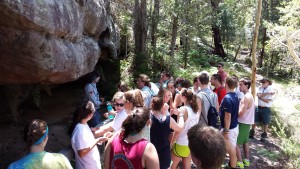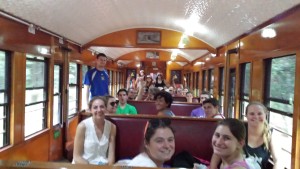Our final day in Australia began at Ku-Ring-Gai National Park outside of Sydney. We met Les, an Aborigine, and several park volunteers who guided us through the day’s activities. Les welcomed us to the land and acknowledged the ancestors, a necessary action to maintain the spirits’ satisfaction.
The Ku-Ring-Gai National Park protects the land that was once inhabited by Aborigines. Stories were recorded by stone carvings and ranged from various punishment tactics to a wedding celebration. Scientists estimate these drawings to several thousand years old, but Les is confident that they are much older.
We proceeded to one of the seasonal shelters that had handprints outlined in red ocha, a soft stone often used for paint. Les demonstrated this Aboriginal art by mixing ocha and water in his mouth and spitting the mixture onto the student volunteers’ hand to form the handprint. Les continued the presentation by offering various plant samples that were medicinal or high in nutrition. He emphasized the relationship with Gaia, Mother Earth, and asked us to think before we use her precious natural resources.
We soon arrived at the cliffs of the Pacific Highway. The Pacific Highway is a large body of water that leads into many different paths. Its name comes from being a type of roadway for many sea mammals such as Southern Wright whales, humpback whales, dolphins, and seals. It is also a natural habitat for Australia’s Fairy Penguins. The southern wright whales use this highway of the ocean for their migration from Antarctica to Australia and vice versa. The water is clear and beautiful.
Many people take residence next to the water on a strip of land that stretches out into the ocean. One of the rangers explained that to live here is extremely expensive because of how pristine the view is and the proximity to the water.
The rangers then led us down the cliffs and through the forest in order to reach a small beach. Wearing bug spray and sunblock are encouraged since there are plenty of bugs while walking though the woods and the UV light in Australia is harsh. It is also highly encouraged to wear sneakers so you have additional comfort on the hike down and your feet are protected from bug bites.
We finally reached the beach and although it was tiny, it was quite nice. The water felt amazing, even though there was a lot of seaweed. There was also some paranoia about the water since we all wanted to avoid jellyfish and other foreign creatures. The rangers warned us not to swim too far out into the water because of the possibility of sharks. None of us wanted to test our luck, so we stayed close to shore and had a great time.
After cooling off and laying in the sun, we left the beach and we headed up the cliffs back to the bus. The way up was rough. The stairs up the cliffs were extremely steep and even after swimming in the cool water, we were drenched in sweat. Going up is certainly much harder then heading down. We eventually ended up back at the bus and said goodbye to the rangers. Many of us fell asleep on the bus ride back to the hotel, which took about an hour. Overall, it was a successful and eventful day.
We concluded our day with several hours of free time. Two students chose to see the opera Tosca at the Sydney Opera House while others spent time at Bondi Beach, explored the Sydney Festival, or shopped. Sydney is an incredible city with a wide range of opportunities for all to enjoy.
As we prepare for our flight back to the states, we reflect on how fortunate we are to study in Australia. Thank you to the family and friends who helped make this experience possible; the friendships and memories made are irreplaceable. We will return to Elon with new insights on Australian culture, history, and the value of environmental sustainability. Thank you again to all who supported us!


















